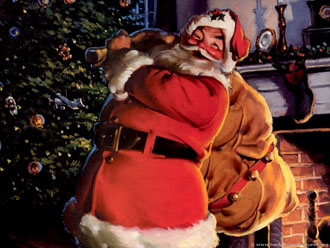圣诞老人的故事 A Brief History of Santa(中英字幕)

On the 24th of December every year, children around the world put out milk and cookies in the hopes of luring a magic fat man into their home who will leave presents behind before sneaking into the house next door.
每年的12月24日,世界各地的孩子都会拿出牛奶及饼干,希望能吸引一名有魔法的胖男人来到他们家,并在偷偷潜入下一户人家前留下礼物。
How did such an odd tradition begin?
这样奇怪的传统是如何开始的?
You can pretty much blame Northern Europe, where the winter weather is cold and dark and depressing. And the coldest and darkest and depressingest day is the Solstice on December 21st to 22nd when the sun only gives a few weak hours of light if any at all.
你几乎可以归咎于北欧,在这里冬天的气候又冷、又暗、令人消沈。而最冷、最暗、最令人消沈的一天是12月21日到22日的冬至,这时即便有阳光,也只会带来几个小时的微弱光明。
These sun-deprived people invented magical characters to visit them and lighten the mood by bringing gifts and celebrations. These characters ranged from elves to Gods to goats, but there are two of particular interest to the modern story.
这些缺乏日光的人们创造出神秘的角色拜访他们,并带来礼物及庆典来放松他们的情绪。这些角色的范围从精灵到神、到山羊都有,但对现代故事来说,其中有两个特别重要。
The first is Saint Nick, in The Netherlands. Saint Nick is thin and perhaps a bit stern, but still brings presents to children in early December. He dresses like a bishop in red and white with a staff and rides on a horse named Amerigo, for whom Dutch children are encouraged to leave out a carrot. Saint Nick is called Sinterklaas in Dutch.
第一个是荷兰的Saint Nick。Saint Nick很瘦,可能还有点严苛,但还是会在12月初带礼物给孩子们。他穿着像主教一样的红白衣服,拿着权仗并骑着一匹名为Amerigo的马,荷兰的孩子们被鼓励留给牠一支红萝卜。Saint Nick的荷兰文叫做Sinterklaas。
The second character is Father Christmas from England. Father Christmas is a big, jolly pagan dressed in green with a holly wreath on his head. Traditionally he is less concerned with children and gifts than he is with food and wine and celebration and is perhaps best known for being one of the three spirits of Christmas who terrorize Scrooge.
第二个角色是从英国来的Father Christmas。Father Christmas是个身材魁梧、快乐的异教徒,穿着绿色衣服,头戴冬青花环。传统上,他跟孩子们及礼物的关系,还不及于他和食物、美酒和庆典的关系,而且也许他最出名的身分可能是三个圣诞节精灵之中,会恐吓Scrooge(吝啬鬼)的那一个。
When Europeans settled the colonies, Saint Nick and Father Christmas and the other characters began to mix together. This explains why the U.S. version has so many names.
当欧洲人安顿好殖民地后,Saint Nick、Father Christmas及其他角色开始融合。这解释了为什么美国的版本有这么多名字。
Santa Claus is the Americanization of Sinterklaas, but he’s also called Saint Nick and Father Christmas and Kris Kringle which comes from Germany. In the old world these were different characters, but in the new world over time they evolved into one which you can see happening in older stories.
圣诞老人是经美国化的Sinterklaas,但他同样也被称为Saint Nick、Father Christmas还有从德国来的Kris Kringle。在旧世界(欧亚非大陆)这些是不同的角色,但在新世界(美洲大陆),他们随着时间合而为一,你可以在较古老的故事中目睹。
For example, the poem “The Night Before Christmas” came out in 1823 in New York, which established that Santa lands on the roof and fills stocking with toys. But this Santa is an elf, much like those from the Nordic Countries. He’s small and drives a miniature sleigh with tiny reindeer, which makes a lot more sense for someone whose job description includes fitting down chimneys. Also, the word “Santa” appears nowhere in the poem. The original title is “A visit from Saint Nick”.
举例来说,「圣诞节前夕」这首诗是在1823年的纽约诞生的,它表明了圣诞老人会降落在屋顶上,并将袜子塞满玩具。但这个圣诞老人是个精灵,很像那些从北欧国家来的。它身材短小,驾着小型雪橇和迷你驯鹿,这对于一个工作内容包括钻进烟囱的人来说合理多了。同样的,「Santa」这个字在诗里任何地方都没有出现。原本的题目是「Saint Nick的探访」。
As the 1800s continued, a fat, human looking immortal Santa evolved into the standard among American authors. It was in the States that he gained both his elvish workforce and a wife.
随着十九世纪过去,一个胖胖的、人类模样、长生不老的圣诞老人发展成了美国作家间的标准。他就是在美国得到了他的精灵工人以及妻子。
By about 1900, Santa had developed into his current iconic style. It should be noted that, contrary to popular belief, Coca-Cola didn’t change his colors to their corporate scheme, but instead used the conveniently red-and-white Santa in 1931 to help sell more soda during their off season. Though Coke didn’t create him, their omnipresent ads probably did brand this as the One True Santa in the minds of millions, helping spread him around the world to many cultures with no traditions of winter gift-givers.
在大约公元1900年时,圣诞老人发展成了现今的经典形象。值得一提的是,与普遍的认知相反,可口可乐并没有将圣诞老人的颜色改成他们的公司企划,而是便利地在1931年时使用红白色的圣诞老人,帮助在淡季时卖出更多可乐。虽然可口可乐并没有创造出他,但他们无所不在的广告可能将这作为「唯一真正的圣诞老人」,铭刻在数百万人的心中,帮助圣诞老人普及于世界上许多没有冬季送礼传统的文化。
This American Santa in turn influenced his relations in Northern Europe to become more like him, although not always to the pleasure of the locals. In particular, the British Father Christmas has been completely assimilated into the Santa collective, to the point where many Britons don’t realize they were ever separate. In the Netherlands, however, Saint Nick is still successfully holding his own as a distinct character.
这个美国版圣诞老人反过来影响了他在北欧的亲戚们,让他们变得更像他,虽然当地人并非总是对此感到开心。特别是英国的Father Christmas已完全被圣诞老人系列给同化,以致于到了许多英国人并没有意识到他们曾经是不同的地步。然而,在荷兰,Saint Nick还是成功地坚持住自己与众不同的特色。
The one last detail about modern Santa that’s still up for debate, at least between countries, is exactly where he lives. In the late 1800s, his home was the magnetic North
Pole, centered under the aurora borealis.
有关现代圣诞老人的最后一个细节是仍有争议的,至少是在国家之间仍有争议,就是他到底住在哪里。在十九世纪晚期,他的家在磁北极,以北极光底下为中心。
While this would be the most diplomatic option for Santa, Magnetic North has since moved off the Polar Ice Sheet and into the ocean — a rather inconvenient place to set up a toy factory.
尽管对圣诞老人来说,这是最圆融的选择,但磁北极自此离开了极地冰原,进入海洋之中–一个比较不方便设立玩具工厂的地方。
So Canada claims his workshop is somewhere in Nunavut and has given Santa a post code and — no joke — official Canadian citizenship. The American response is that the North Pole doesn’t refer to the obviously inhospitable sheet of non-domestic ice but rather to the little town of North Pole, Alaska. Denmark claims he lives in their former colony of Greenland. And Greenland, not surprisingly, agrees.
所以加拿大声称他的工作坊是在Nunavut某处,并提供圣诞老人一个邮政编码,还有–没在开玩笑–正式的加拿大公民身分。美方的响应是,北极指的并不是明显荒凉、不适宜居住的冰层,而是阿拉斯加的一个小镇,North Pole镇。丹麦声称他住在他们的前殖民地格陵兰。而格陵兰,不意外的,也同意这说法。
The Nordic countries quarrel about his exact location, but Finland is the clear winner of this argument with his workshop in Rovaniemi on the Arctic Circle. For the evidence inclined, you can actually go visit Santa and see the elves, toys, reindeer and post office, which makes Finland’s claim pretty strong. Santa is even available during the off-season.
北欧国家争论他确切的所在地,但芬兰这关于他的工作坊在北极圈的Rovaniemi市的说法,在这场争执中显然是个赢家。为寻找有力证据,你可以实际上过去拜访圣诞老人,并看看精灵、玩具、驯鹿和邮局,这些使得芬兰的声明相当有力。甚至在圣诞节以外的季节也能看到圣诞老人。
But no matter where he might be based, Santa still manages to get around the world in just one night to deliver all those presents… and eat all those cookies.
但不管他可能以何处为基地,圣诞老人仍设法在仅仅一个晚上环游世界递送所有礼物…并吃掉所有饼干。
每年的12月24日,世界各地的孩子都会拿出牛奶及饼干,希望能吸引一名有魔法的胖男人来到他们家,并在偷偷潜入下一户人家前留下礼物。
这样奇怪的传统是如何开始的?
你几乎可以归咎于北欧,在这里冬天的气候又冷、又暗、令人消沈。而最冷、最暗、最令人消沈的一天是12月21日到22日的冬至,这时即便有阳光,也只会带来几个小时的微弱光明。
这些缺乏日光的人们创造出神秘的角色拜访他们,并带来礼物及庆典来放松他们的情绪。这些角色的范围从精灵到神、到山羊都有,但对现代故事来说,其中有两个特别重要。
第一个是荷兰的Saint Nick。Saint Nick很瘦,可能还有点严苛,但还是会在12月初带礼物给孩子们。他穿着像主教一样的红白衣服,拿着权仗并骑着一匹名为Amerigo的马,荷兰的孩子们被鼓励留给牠一支红萝卜。Saint Nick的荷兰文叫做Sinterklaas。
第二个角色是从英国来的Father Christmas。Father Christmas是个身材魁梧、快乐的异教徒,穿着绿色衣服,头戴冬青花环。传统上,他跟孩子们及礼物的关系,还不及于他和食物、美酒和庆典的关系,而且也许他最出名的身分可能是三个圣诞节精灵之中,会恐吓Scrooge(吝啬鬼)的那一个。
当欧洲人安顿好殖民地后,Saint Nick、Father Christmas及其他角色开始融合。这解释了为什么美国的版本有这么多名字。
圣诞老人是经美国化的Sinterklaas,但他同样也被称为Saint Nick、Father Christmas还有从德国来的Kris Kringle。在旧世界(欧亚非大陆)这些是不同的角色,但在新世界(美洲大陆),他们随着时间合而为一,你可以在较古老的故事中目睹。
举例来说,「圣诞节前夕」这首诗是在1823年的纽约诞生的,它表明了圣诞老人会降落在屋顶上,并将袜子塞满玩具。但这个圣诞老人是个精灵,很像那些从北欧国家来的。它身材短小,驾着小型雪橇和迷你驯鹿,这对于一个工作内容包括钻进烟囱的人来说合理多了。同样的,「Santa」这个字在诗里任何地方都没有出现。原本的题目是「Saint Nick的探访」。
随着十九世纪过去,一个胖胖的、人类模样、长生不老的圣诞老人发展成了美国作家间的标准。他就是在美国得到了他的精灵工人以及妻子。
在大约公元1900年时,圣诞老人发展成了现今的经典形象。值得一提的是,与普遍的认知相反,可口可乐并没有将圣诞老人的颜色改成他们的公司企划,而是便利地在1931年时使用红白色的圣诞老人,帮助在淡季时卖出更多可乐。虽然可口可乐并没有创造出他,但他们无所不在的广告可能将这作为「唯一真正的圣诞老人」,铭刻在数百万人的心中,帮助圣诞老人普及于世界上许多没有冬季送礼传统的文化。
这个美国版圣诞老人反过来影响了他在北欧的亲戚们,让他们变得更像他,虽然当地人并非总是对此感到开心。特别是英国的Father Christmas已完全被圣诞老人系列给同化,以致于到了许多英国人并没有意识到他们曾经是不同的地步。然而,在荷兰,Saint Nick还是成功地坚持住自己与众不同的特色。
有关现代圣诞老人的最后一个细节是仍有争议的,至少是在国家之间仍有争议,就是他到底住在哪里。在十九世纪晚期,他的家在磁北极,以北极光底下为中心。
尽管对圣诞老人来说,这是最圆融的选择,但磁北极自此离开了极地冰原,进入海洋之中–一个比较不方便设立玩具工厂的地方。
所以加拿大声称他的工作坊是在Nunavut某处,并提供圣诞老人一个邮政编码,还有–没在开玩笑–正式的加拿大公民身分。美方的响应是,北极指的并不是明显荒凉、不适宜居住的冰层,而是阿拉斯加的一个小镇,North Pole镇。丹麦声称他住在他们的前殖民地格陵兰。而格陵兰,不意外的,也同意这说法。
北欧国家争论他确切的所在地,但芬兰这关于他的工作坊在北极圈的Rovaniemi市的说法,在这场争执中显然是个赢家。为寻找有力证据,你可以实际上过去拜访圣诞老人,并看看精灵、玩具、驯鹿和邮局,这些使得芬兰的声明相当有力。甚至在圣诞节以外的季节也能看到圣诞老人。
但不管他可能以何处为基地,圣诞老人仍设法在仅仅一个晚上环游世界递送所有礼物…并吃掉所有饼干。

On the 24th of December every year, children around the world put out milk and cookies in the hopes of luring a magic fat man into their home who will leave presents behind before sneaking into the house next door.
How did such an odd tradition begin?
You can pretty much blame Northern Europe, where the winter weather is cold and dark and depressing. And the coldest and darkest and depressingest day is the Solstice on December 21st to 22nd when the sun only gives a few weak hours of light if any at all.
These sun-deprived people invented magical characters to visit them and lighten the mood by bringing gifts and celebrations. These characters ranged from elves to Gods to goats, but there are two of particular interest to the modern story.
The first is Saint Nick, in The Netherlands. Saint Nick is thin and perhaps a bit stern, but still brings presents to children in early December. He dresses like a bishop in red and white with a staff and rides on a horse named Amerigo, for whom Dutch children are encouraged to leave out a carrot. Saint Nick is called Sinterklaas in Dutch.
The second character is Father Christmas from England. Father Christmas is a big, jolly pagan dressed in green with a holly wreath on his head. Traditionally he is less concerned with children and gifts than he is with food and wine and celebration and is perhaps best known for being one of the three spirits of Christmas who terrorize Scrooge.
When Europeans settled the colonies, Saint Nick and Father Christmas and the other characters began to mix together. This explains why the U.S. version has so many names.
Santa Claus is the Americanization of Sinterklaas, but he’s also called Saint Nick and Father Christmas and Kris Kringle which comes from Germany. In the old world these were different characters, but in the new world over time they evolved into one which you can see happening in older stories.
For example, the poem “The Night Before Christmas” came out in 1823 in New York, which established that Santa lands on the roof and fills stocking with toys. But this Santa is an elf, much like those from the Nordic Countries. He’s small and drives a miniature sleigh with tiny reindeer, which makes a lot more sense for someone whose job description includes fitting down chimneys. Also, the word “Santa” appears nowhere in the poem. The original title is “A visit from Saint Nick”.
As the 1800s continued, a fat, human looking immortal Santa evolved into the standard among American authors. It was in the States that he gained both his elvish workforce and a wife.
By about 1900, Santa had developed into his current iconic style. It should be noted that, contrary to popular belief, Coca-Cola didn’t change his colors to their corporate scheme, but instead used the conveniently red-and-white Santa in 1931 to help sell more soda during their off season. Though Coke didn’t create him, their omnipresent ads probably did brand this as the One True Santa in the minds of millions, helping spread him around the world to many cultures with no traditions of winter gift-givers.
This American Santa in turn influenced his relations in Northern Europe to become more like him, although not always to the pleasure of the locals. In particular, the British Father Christmas has been completely assimilated into the Santa collective, to the point where many Britons don’t realize they were ever separate. In the Netherlands, however, Saint Nick is still successfully holding his own as a distinct character.
The one last detail about modern Santa that’s still up for debate, at least between countries, is exactly where he lives. In the late 1800s, his home was the magnetic North
Pole, centered under the aurora borealis.
While this would be the most diplomatic option for Santa, Magnetic North has since moved off the Polar Ice Sheet and into the ocean — a rather inconvenient place to set up a toy factory.
So Canada claims his workshop is somewhere in Nunavut and has given Santa a post code and — no joke — official Canadian citizenship. The American response is that the North Pole doesn’t refer to the obviously inhospitable sheet of non-domestic ice but rather to the little town of North Pole, Alaska. Denmark claims he lives in their former colony of Greenland. And Greenland, not surprisingly, agrees.
The Nordic countries quarrel about his exact location, but Finland is the clear winner of this argument with his workshop in Rovaniemi on the Arctic Circle. For the evidence inclined, you can actually go visit Santa and see the elves, toys, reindeer and post office, which makes Finland’s claim pretty strong. Santa is even available during the off-season.
But no matter where he might be based, Santa still manages to get around the world in just one night to deliver all those presents… and eat all those cookies.

